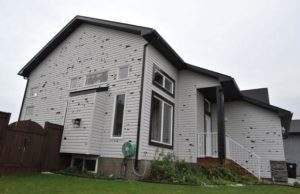ABBOTTS BLOG
How to Handle Hail Damage to Your Home

If you live in an area where hailstorms are common, you are no stranger to the damage they can cause. From dented vehicles to shredded foliage, the aftermath of a hailstorm is often readily apparent. You might rush out to move your car into the garage the moment it starts to hail, but don’t forget that hail can also cause extensive damage to your roof and other parts of your home.
After a hailstorm, there are important steps that you should take to ensure damage to your home is properly assessed, reported, and repaired. For more help with hail damage please watch our hail damage restoration video.
Don’t Delay
If you have experienced a hailstorm of any magnitude, it is important to check your property for damage. According to Allstate, homeowners insurance generally covers damage from hailstorms, but there is a time limit when it comes to reporting damage from a storm. Skilled insurance adjusters can tell when hail damage occurred, so waiting too long can weaken your claim.
Also, any damage that occurs because of delays on your end are not covered. For instance, if hail damage causes softening of shingles that eventually leads to more major problems with your roof leaking, you are going to have trouble making your case if you don’t do your part and both report and mitigate the damage early on.
Get Photographic Evidence
Something to think of before you are hit by hail in the first place is establishing some basic photo documentation of your home. By having “before” pictures, you make it much easier for damages to be assessed (and proven) after a storm hits.
After a hailstorm, taking pictures should go hand in hand with your entire hail damage inspection. Take pictures of any indicators of hail damage, both on and around your home. Use chalk to mark areas of impact, and also to make dents that are not easily seen more apparent. To do this, run the chalk sideways along the dent.
Begin Your Hail Damage Inspection on the Ground
 To determine whether you need to take the trip up the ladder to your rooftop to do some more involved inspection, first do some hail damage inspection from the ground. In particular, look for:
To determine whether you need to take the trip up the ladder to your rooftop to do some more involved inspection, first do some hail damage inspection from the ground. In particular, look for:
- Damage to siding, window sills, and window casings
- Chips in the paint on your home’s exterior
- Dings or dents in outdoor appliances, such as air conditioning units
- Dented gutters or downspouts
- Dings in the stain or paint on your deck or porch
- Granules in your gutters and/or around your drainpipe (indicates severe damage to roofing)
If you find these types of damage, you likely also have hail damage on your roof. It is important to note that these damages are also likely covered by your homeowners insurance (even if roof damage is unknown at this point), so you could consider calling in hail damage specialists at this juncture to take a closer look and provide a quote.
Hail damage restoration specialists can do the roof inspection for you, saving you both the time and hassle of doing so yourself. Of course, you can choose to do this piece on your own as well — it is up to you.
Move up to the Roof
 If there is any damage on the ground or to the sides of your home, it’s time to inspect your roof. Of course, safety is of the essence. Only do what you are capable of doing safely, and take common-sense precautions. Bring a buddy with you to hold the ladder, wear soft-soled shoes, and don’t go up when it is raining or the roof is slick.
If there is any damage on the ground or to the sides of your home, it’s time to inspect your roof. Of course, safety is of the essence. Only do what you are capable of doing safely, and take common-sense precautions. Bring a buddy with you to hold the ladder, wear soft-soled shoes, and don’t go up when it is raining or the roof is slick.
Different types of roofing display damage in different ways. Keep in mind that even what appears to be minor damage, such as a few granules missing from your shingles, can be more important than you think. Shingles in particular are made to be very sturdy, and missing granules can lead to soft spots that collect water during the next storm, and lead to more extensive damage in the long term. (This is a great example of something your insurance company can use to prove you haven’t done your due diligence and acted in a timely manner.)
Here are ways to spot damage in various types of roofing:
- Asphalt shingles:
- Inspect for missing pieces of asphalt and areas where you can see the black substrate, as this indicates missing asphalt granules
- Look for “bruising” by feeling for dimples on the shingle’s surface and seeing whether those dimples have any give
- Inspect for circular cracks in the shingles
- Wood shingles usually split down the middle when they have been damaged by hail
- Metal roofing shows hail damage as round dings
- Slate and clay roofing demonstrate obvious cracks or gouges
Your best bet is to bring in a hail damage restoration specialist who can assess the damage, provide you with estimates for both the cost and timeframe of the repairs, and perform the restoration. An experienced restoration service provider such as Abbotts will act as a middleman between you and your insurance company, ensuring you are very clear about what repairs will be covered by insurance and can make fully informed decisions.
The thing to remember after any hailstorm is that your insurance should likely cover the repairs, but it is your responsibility to take certain steps. You need to act swiftly and thoroughly, documenting every step of the way. This process can be overwhelming, and Abbotts is here to help. Contact us today for a free estimate, and let us help you get your home back to it pre-loss condition while working with your insurance company on your behalf.

